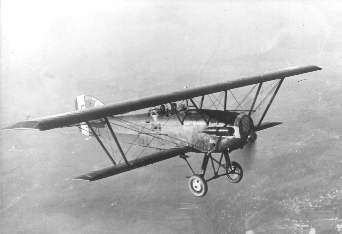
Potez 25
Potez 25 (also written as Potez XXV) was a French twin-seat, single-engine biplane designed during the 1920s.
About Potez 25 – Source Wikipedia
Role: Reconnaissance bomber
Manufacturer: Potez
First flight: 1924
Introduction: 1925
Retired: 1940s
Primary users: French Air Force, Polish Air Force
Number built: 4,000 (2,500 in France)
Specifications (560)
General characteristics
- Crew: Two
- Length: 9.2 m (30 ft 2 in)
- Wingspan: 14.14 m (46 ft 5 in)
- Height: 3.59 m (11 ft 9 in)
- Wing area: 51.4 m² (553 ft²)
- Empty weight: 1,490 kg (3,278 lb)
- Loaded weight: 2,558 kg (5,268 lb)
- Useful load: 1,068 kg (2,350 lb)
- Powerplant: 1 × Lorraine-Dietrich 12 Eb water-cooled W12 inline engine, 357 kW (478 hp)
Performance
- Maximum speed: 214 km/h (115 kn, 132 mph)
- Range: 600 km (324 nmi, 373 mi)
- Service ceiling: 5,500 m (18,000 ft)
- Rate of climb: 3.5 m/s (690 ft/min)
- Wing loading: 49.8 kg/m² (9.53 lb/ft²)
- Power/mass: 0.14 kW/kg (0.91 hp/lb)

Potez 25
Potez 25 (also written as Potez XXV) was a French twin-seat, single-engine biplane designed during the 1920s.
The aircraft was further developed into the 25M, a standard parasol-wing monoplane, which never entered production.
Design and development
In 1923, the Avions Henry Potez aircraft works started production of a successful Potez 15 reconnaissance biplane. Basing on experience gathered during the construction of that plane, Henry Potez started working on a new design of a heavier and faster multi-purpose plane. Designated Potez XXV or Potez 25, the prototype was built already in 1924. The main differences included a larger, more powerful engine and a new wing design. Instead of a classic biplane, Potez introduced a sesquiplane, with the lower wing significantly smaller. It was built in two main military variants: Potez 25A2 reconnaissance plane and Potez 25B2 bomber-reconnaissance plane.
In May 1925, the prototype was tested at the Service Technique d’Aeronautique Institute and was found a promising construction both for its manoeuvrability, speed and durability. Following the tests, the prototype entered serial production. To promote the new plane abroad, in a post-World War I markets filled with hundreds of cheap demobilized planes, the Potez 25 was entered into a large number of races. Among the best-known achievements was a European rally (7,400 km/4,598 mi) and a Mediterranean rally (6,500 km/4,039 mi), both won by pilots flying the Potez. In 1920s, the Potez 25 was also used in a well-advertised Paris-Tehran rally (13,080 km/8,127 mi). In June 1930, Henri Guillaumet crashed with his Potez 25 in the Andes during an air mail flight. He survived an incredible march through the mountains and was found after one week of searching.
Such achievements added to plane’s popularity and made it one of the most successful French planes of the epoch. It was bought by a number of air forces, including those of France, Switzerland, Belgium, Brazil, Croatia, Estonia, Ethiopia, Finland, Greece, Spain, Japan, Yugoslavia, Poland and Portugal, as well as Romania, Turkey and the USSR, although USSR, having acquired two planes for testing, later decided against further purchases, finding it roughly equal to the native Polikarpov R-5. Altogether, roughly 2,500 planes were built in France.
Already in 1925, Poland bought a license for Potez 25 and started to manufacture them in Podlaska Wytwórnia Samolotów (PWS, 150 built) and Plage i Laśkiewicz aircraft works (150 built). In 1928 the first Polish-built Potez 25 were tested by the Technical Aviation Development Institute in Warsaw and the design was slightly modified to better fit the needs of the Polish air forces. Among the notable differences were the introduction of leading edge slots. The production in Poland ceased in 1932. Altogether, 300 planes were built in a number of versions for long- and short-range reconnaissance and daylight tactical bombing. As the original Lorraine-Dietrich 12Eb engine was unavailable in Poland, it was replaced in 47 aircraft with a more powerful PZL Bristol Jupiter VIIF radial engine, starting from 1936.
Several other countries manufactured Potez 25s under licence.
Variants
Potez 25 1925 experimental
One prototype aircraft, powered by a 336 kW (450 hp) Hispano-Suiza 12Ga engine.
Potez 25 A.2
Two-seat observation version, powered by a 388 kW (520 hp) Salmson 18Cmb or Lorraine 12Eb engine.
Potez 25 ET.2
Two-seat intermediate training version, powered by a 373 kW (500 hp) Salmson 18Ab radial engine.
Potez 25 “Jupiter”
Export version, powered by a 313 kW (420 hp) Gnome-Rhone 9Ac Jupiter radial. Built under licence by Ikarus in Yugoslavia and OSGA in Portugal, exported to Estonia and Switzerland.
Potez 25/5
Production version, powered by a 373 kW (500 hp) Renault 12Jb. 100 built.
Potez 25 TOE
Major production version. 2,270 built.
Potez 25 GR
Long-range version.
Potez 25 M
One Hispano-Suiza powered aircraft was converted into a parasol-wing monoplane.
Potez 25 Hispano-Suiza
VIP transport version, powered by a 447 kW (600 hp) Hispano-Suiza 12Lb.
Potez 25 Farman
Two-seat observation version for the French Air Force, powered by a 373 kW (500 hp) Farman 12We. Also known as the Potez 25/4. 12 built.
Potez 25/35
Two-seat target-tug version.
Potez 25/55
Two-seat training version. 40 built.
Potez 25-O
Specially strengthened and modified version, built for a non-stop North-Atlantic crossing. The aircraft was powered by a Jupiter radial, fitted with jettisonable landing gear and a strengthened landing skid. Only two were built.
Potez 25-H
Two floatplane prototypes, each one was powered by the Gnome-Rhone Jupiter radial.
